Fostering Multi-Functional Urban Agriculture: Experiences from the Champions in a Revitalized Farm Pond Community in Taoyuan, Taiwan
Abstract
:1. Introduction
2. Urban Agriculture Development in Taiwan
- (1)
- Tourist farm: Sightseeing and fruit/tea/flower picking;
- (2)
- Citizen farm: Farming experience;
- (3)
- Leisure farm: A longer stay with diverse activities; and
- (4)
- Educational farm: Agricultural/environmental education.
3. Farm Ponds in Taiwan
4. Methods
4.1. The Study Area
4.2. Data Collection
- (1)
- What are the resources that are unique to Gaoyuan for its future development?
- (2)
- What are your experiences in participating in local community affairs?
- (3)
- What are the challenges and opportunities as Gaoyuan evolves toward a farm-pond-based UA community?
5. Results
5.1. Landscape Character
“Farm ponds and the surroundings are the precious property left by our ancestors to us. So we cannot let them disappear and must keep them well-maintained … to promote their potential uses and values as a water and green resource … such as the production of organic and non-toxic vegetables for our own community.”
“We usually walk around the farm pond … to see the changes of seasons, to see the farmlands, to see the vegetables we grow, to see them grow up day by day ... or just walk around to experience the nature … we feel happy, content with that.”
“I was born here … why we still live here because of its air, quietness, environment, atmosphere … but new developments, such as high-tech factories, raise local concerns about the impact on lifestyle and environment … thus we hope to maintain the original, desirable landscape of Gaoyuan … what we do is small-scale community farming and landscaping to bring back the agricultural-community-like pondscape that is full of our memories living here.”
“We would say that accessing water is human nature. For an agricultural, farm-pond community, coexistence with nature is the central value. We cannot live without it … openness of view, clean water, fresh air, tall trees, good agricultural productivity, diverse wildlife, feelings of relaxation, stress relief … to live a healthy life ... I desire this kind of environment.”
5.2. Active Engagement, Participation, and the Agency of People
“What is the motivation for participating in the community affairs … I think because this is my hometown. If we can do, we of course come together to help. We are happy for doing this. Because this is true happiness, it can be naturally disseminated to other people.”
“We can have such achievements, and these will encourage ourselves to go further … the more we work, the more inspired we feel.”(IV2)
“The physical exhaustion is totally offset by the sense of achievement!”(IV3)
“I am good at organic farming, but when the farm pond workers are building bamboo rafts and artificial floating islands, I have no idea about that, so I am willing to see what they are doing, to learn from them … Sometimes we stop our work, take a rest, and maybe help the Mugwort farmers with a little work, such as passing organic fertilizers to them. We can chat to each other about what we do, the life, the community. This is very relaxing with friends.”
“No matter how the farm pond is redeveloped, we must preserve its ecology, even create more ecological values within the area … the use of artificial floating islands is not just for growing non-toxic vegetables, it can also create biodiversity and wildlife habitats that attract dragonflies, turtles, fishes and others … you can even see turtles climbing up the floating island to sunbathe … it is an ecology, and a landscape, too. Its benefits expand gradually.”
“When we work together, especially students coming, I feel I am more cheerful, more energetic. It seems that I am 10 years younger!”
5.3. Social Cohesion and Well-Being
“I think we have done it very well! ... not just for some groups of people, but for all the community members, including the elderly, middle-aged adults, and children … Our activities arranged that we can take care of different people, everyone can gather together at various events. This helps us get united.”
“In Gaoyuan, a range of working groups has been set up and operated individually for promoting community affairs. This is the idea of empowerment ... The community is like a center that links everyone, every group, who are working cooperatively and effectively ... During the process, the role of government is to encourage community autonomy ... to establish their own characters, like Gaoyuan.”
“There is a general consensus among us that we all work for the community … we are given the power to do what we can do on our own positions ... we are working quite happily, with good collaboration. If the community needs us, we definitely join in and work together.”
“When seeing the elderly are happy to eat the food we grow … how to say … I am very happy, emotional … a sense of achievement … doesn’t feel it is hard work.”
6. Discussions: The Function of UA in Place-Making for an Agricultural Landscape
7. Conclusions
- The specific landscape character, which links nearby nature to people, a green network of diverse spaces, low-impact landscaping, and an agricultural-community-like pondscape, makes UA in Gaoyuan distinctive.
- Through the contribution of active engagement, participation, and agency by the local people, the process of implementing farm-pond-based UA features cooperative working, mutual learning, and experience-sharing.
- UA plays a vital role in shaping social cohesion, which encourages motivated, committed participation in community affairs at an individual level, and contributes to a robust and effective social network at a community level. Their combined effects on people’s health and well-being and community revitalization can be considerable.
- A cohesive social network has been developed in Gaoyuan that involves agricultural life, crop production, ecological environment, and community care.
Acknowledgments
Author Contributions
Conflicts of Interest
References
- De Bon, H.; Parrot, L.; Moustier, P. Sustainable urban agriculture in developing countries: A review. Agron. Sustain. Dev. 2010, 30, 21–32. [Google Scholar] [CrossRef]
- Vejre, H.; Simon-Rojo, M. Introduction. In Urban Agriculture Europe; Lohrberg, F., Licka, L., Scazzosi, L., Timpe, A., Eds.; Jovis: Berlin, Germany, 2016; pp. 16–17. [Google Scholar]
- Mougeot, L.J.A. Urban agriculture: Definition, presence, potential and risks. In Growing Cities, Growing Foods: Urban Agriculture on the Policy Agenda; Bakker, N., Dubbeling, M., Grundel, S., Sabel-Koschella, U., de Zeeuw, H., Eds.; DSE: Feldafing, Germany, 2000; pp. 1–42. [Google Scholar]
- Lovell, S.T. Multifunctional urban agriculture for sustainable land use planning in the United States. Sustainability 2010, 2, 2499–2522. [Google Scholar] [CrossRef]
- Simon-Rojo, M.; Recasens, X.; Callau, S.; Duží, B.; Eiter, S.; Hernández Jiménez, V.; Kettle, P.; Laviscio, R.; Lohrberg, F.; Pickard, D.; et al. From urban food gardening to urban farming. In Urban Agriculture Europe; Lohrberg, F., Licka, L., Scazzosi, L., Timpe, A., Eds.; Jovis: Berlin, Germany, 2016; pp. 22–28. [Google Scholar]
- Napawan, N.C.; Burke, E. Productive potential: Evaluating residential urban agriculture. Lands. Res. 2016, 41, 773–779. [Google Scholar] [CrossRef]
- Aubry, C.; Ramamonjisoa, J.; Dabat, M.H.; Rakotoarisoa, J.; Rakotondraibe, J.; Rabeharisoa, L. Urban agriculture and land use in cities: An approach with the multi-functionality and sustainability concepts in the case of Antananarivo (Madagascar). Land Use Policy 2012, 29, 429–439. [Google Scholar] [CrossRef]
- Ali, M.; de Bon, H.; Moustier, P. Promoting the multifunctionality of urban and periurban agriculture in Hanoi. Urban Agric. Mag. 2005, 15, 11–13. [Google Scholar]
- Souter-Brown, G. Landscape and Urban Design for Health and Well-Being: Using Healing, Sensory and Therapeutic Gardens; Routledge: Abingdon, UK, 2015. [Google Scholar]
- Sanesi, G.; Colangelo, G.; Lafortezza, R.; Calvo, E.; Davies, C. Urban green infrastructure and urban forests: A case study of the Metropolitan Area of Milan. Landsc. Res. 2017, 42, 164–175. [Google Scholar] [CrossRef]
- Hou, J.; Johnson, J.; Lawson, L. Green Cities, Growing Communities: Learning from Seattle’s Urban Community Gardens; University of Washington Press: Seattle, WA, USA, 2009. [Google Scholar]
- Gorgolewski, M.; Komisar, J.; Nasr, J. Carrot City: Creating Places for Urban Agriculture; Monacelli Press: New York, NY, USA, 2011. [Google Scholar]
- Lohrberg, F.; Licka, L.; Scazzosi, L.; Timpe, A. (Eds.) Urban Agriculture Europe; Jovis: Berlin, Germany, 2016. [Google Scholar]
- Jahrl, I.; Schmid, O. Policies fostering multifunctional urban agriculture in the city of Zurich. Urban Agric. Mag. 2015, 29, 30–31. [Google Scholar]
- Renting, H.; Naneix, C.; Dubbeling, M.; Cai, J. Innovative Experiences with Multifunctional Urban and Peri-urban Agriculture in City Regions in the Global South; SUPURBFOOD; RUAF Foundation: Leusden, The Netherlands, 2013. [Google Scholar]
- Redwood, M. Agriculture in Urban Planning: Generating Livelihoods and Food Security; Earthscan: London, UK, 2009. [Google Scholar]
- Orsini, F.; Kahane, R.; Nono-Womdim, R.; Gianquinto, G. Urban agriculture in the developing world: A review. Agron. Sustain. Dev. 2013, 33, 695–720. [Google Scholar] [CrossRef]
- Van Veenhuizen, R. (Ed.) Introduction: Cities farming for the future. In Cities Farming for the Future: Urban Agriculture for Green and Productive Cities; RUAF Foundation: Leusden, The Netherlands, 2006; pp. 1–17. [Google Scholar]
- Van Veenhuizen, R.; Danso, G. Profitability and Sustainability of Urban and Peri-Urban Agriculture; Agricultural Management, Marketing and Finance Occasional Paper No. 19; FAO: Rome, Italy, 2007. [Google Scholar]
- Campbell, M.C. Building a common table: The role for planning in community food systems. J. Plan. Educ. Res. 2004, 23, 341–355. [Google Scholar] [CrossRef]
- Orsini, F.; Gasperi, D.; Marchetti, L.; Piovene, C.; Draghetti, S.; Ramazzotti, S.; Bazzocchi, G.; Gianquinto, G. Exploring the production capacity of rooftop gardens (RTGs) in urban agriculture: The potential impact on food and nutrition security, biodiversity and other ecosystem services in the city of Bologna. Food Secur. 2014, 6, 781–792. [Google Scholar] [CrossRef]
- Specht, K.; Siebert, R.; Hartmann, I.; Freisinger, U.B.; Sawicka, M.; Werner, A.; Thomaier, S.; Henckel, D.; Walk, H.; Dierich, A. Urban agriculture of the future: An overview of sustainability aspects of food production in and on buildings. Agric. Hum. Values 2014, 31, 33–51. [Google Scholar] [CrossRef]
- Pölling, B.; Alfranca, Ó.; Alves, E.; Andersson, G.; Branduini, P.; Egloff, L.D.; Giacchè, G.; Heller, A.; Herkströter, K.; Kemper, D.; et al. Creating added value: Societal benefits of urban agriculture. In Urban Agriculture Europe; Lohrberg, F., Licka, L., Scazzosi, L., Timpe, A., Eds.; Jovis: Berlin, Germany, 2016; pp. 92–100. [Google Scholar]
- Food and Agriculture Organization. Background Paper 1: Agricultural Biodiversity. In Proceedings of the Multifunctional Character of Agriculture and Land Conference, Maastricht, The Netherlands, 12–17 September 1999. [Google Scholar]
- Food and Agriculture Organization. Building on Gender, Agrobiodiversity and Local Knowledge; FAO: Rome, Italy, 2004. [Google Scholar]
- Gasperi, D.; Pennisi, G.; Rizzati, N.; Magrefi, F.; Bazzocchi, G.; Mezzacapo, U.; Centrone Stefani, M.; Sanyé-Mengual, E.; Orsini, F.; Gianquinto, G. Towards regenerated and productive vacant areas through urban horticulture: Lessons from Bologna, Italy. Sustainability 2016, 8, 1347. [Google Scholar] [CrossRef]
- Thomaier, S.; Specht, K.; Henckel, D.; Dierich, A.; Siebert, R.; Freisinger, U.B.; Sawicka, M. Farming in and on urban buildings: Present practice and specific novelties of Zero-Acreage Farming (ZFarming). Renew. Agric. Food Syst. 2015, 30, 43–54. [Google Scholar] [CrossRef]
- McClintock, N.; Cooper, J.; Khandeshi, S. Assessing the potential contribution of vacant land to urban vegetable production and consumption in Oakland, California. Landsc. Urban Plan. 2013, 111, 46–58. [Google Scholar] [CrossRef]
- Austin, G. Green Infrastructure for Landscape Planning: Integrating Human and Natural Systems; Routledge: Abingdon, UK, 2014. [Google Scholar]
- Paradis, S.; Cieszewska, A.; Tóth, A.; Šuklje-Erjavec, I. Agriculture in urban space. In Urban Agriculture Europe; Lohrberg, F., Licka, L., Scazzosi, L., Timpe, A., Eds.; Jovis: Berlin, Germany, 2016; pp. 120–125. [Google Scholar]
- Roe, M.; Sarlöv Herlin, I.; Speak, S. Identity, food and landscape character in the urban context. Landsc. Res. 2016, 41, 757–772. [Google Scholar] [CrossRef]
- Napawan, N.C.; Townsend, S.A. The landscape of urban agriculture in California’s capital. Landsc. Res. 2016, 41, 780–794. [Google Scholar] [CrossRef]
- Colasanti, K.J.A.; Hamm, M.W.; Litjens, C.M. The city as an “agricultural powerhouse”? Perspectives on expanding urban agriculture from Detroit, Michigan. Urban Geogr. 2012, 33, 348–369. [Google Scholar] [CrossRef]
- Council of Agriculture (CoA). Policy—Transforming Taiwan’s Agriculture from Traditional to a Modern One. 2015. Available online: http://eng.coa.gov.tw/theme_list.php?theme=eng_policies (accessed on 24 July 2017).
- Chen, W.J. Eat homegrown foods: The global popularity of urban farming. Taipei Q. 2016, 4, 16–19. [Google Scholar]
- Shi, T.V. Urban agriculture: Green sprawl in concrete jungle. Green Build. 2015, 35, 36–40. (In Chinese) [Google Scholar]
- Chung, W.P. Basking in a green radiance: The whole city is my garden. Taipei Q. 2016, 4, 25–29. [Google Scholar]
- Chiu, Y.H. Urban Agriculture: Developing a New Vision of the Garden City. 2015. Available online: http://www.taipeiecon.taipei/article_cont.aspx?MSid=654073513535250113&MmmID=1201&CatID=653635047463112672 (accessed on 25 July 2017). (In Chinese).
- Chou, R.J.; Wu, C.T.; Huang, F.T. The Typology and Practice of Healthy Landscape: The Case Study of Xia-Dian-Zi Farm Pond in Gaoyuan Community, Longtan. In Proceedings of the 2016 National Landscape Forum, Taoyuan, Taiwan, 10 December 2016. (In Chinese). [Google Scholar]
- Taoyuan City Government (TYCG). Presentation of Taoyuan Community Planner Local Participation Plan: Mayor Zheng Indicated the Importance of Community Building to Identify Different Features of Different Communities. 2016. Available online: http://www.tycg.gov.tw/ch/home.jsp?id=9&parentpath=0,1&mcustomize=multimessage_view.jsp&dataserno=201604150001&aplistdn=ou=news,ou=chinese,ou=ap_root,o=tycg,c=tw&toolsflag=Y (accessed on 26 July 2017). (In Chinese)
- The Liberty Times. The Exhibition of Taoyuan Community Building, Seventeen Communities Awarded. 15 April 2016. Available online: http://news.ltn.com.tw/news/life/breakingnews/1665083 (accessed on 26 July 2017). (In Chinese).
- Chen, X.J. Ideas from learning from Taiwan to develop Fuzhou’s urban agriculture. Chin. Hortic. Abstr. 2016, 12, 65–66. (In Chinese) [Google Scholar]
- Yen, C.H. Improving Environment and Economy through Urban and Peri-urban Agriculture: A Case of Agri-tourism in Taiwan. In Proceedings of the 2006 Urban/Peri-Urban Agriculture in the Asian and Pacific region, Tagaytay City, Philippines, 22–26 May 2006. [Google Scholar]
- Chou, Z.L.; Shi, W.K. The implication of Taiwan’s urban agriculture development for Kunming’s urban farms. J. Changchun Univ. Sci. Technol. 2013, 26, 74–84. (In Chinese) [Google Scholar]
- Tuan, C.L. A Review of Taiwan’s Urban Agriculture Development and Future Development Strategies. 2007. Available online: http://www.coa.gov.tw/ws.php?id=12560 (accessed on 9 August 2017). (In Chinese)
- Li, Q.Z. A Study on the Development of Leisure Farms and Management Challenges in Taiwan. In Proceedings of the 3rd Conference on Sport Science and Recreational Management, Pingtung, Taiwan, 10–11 December 2010. (In Chinese). [Google Scholar]
- Xin, W. Urban agriculture in Taiwan. Beijing Agric. 2012, 13, 46–47. (In Chinese) [Google Scholar]
- Zheng, J.X.; Tsai, Q.Z. The development experiences of citizen farms in Taiwan. Taichung Dist. Agric. Promot. Newsl. 1995, 143, 1–17. (In Chinese) [Google Scholar]
- Wen, H. A brief of contemporary agriculture in Taiwan. Anc. Mod. Agric. 2004, 4, 17–24. (In Chinese) [Google Scholar]
- Du, Y. Cultivating edible landscapes: Creating a garden city. Taipei Q. 2016, 4, 20–24. [Google Scholar]
- The Liberty Times. Managing a Citizen Farm, Not an Easy Work. 27 August 2011. Available online: http://news.ltn.com.tw/news/local/paper/519648 (accessed on 11 August 2017). (In Chinese).
- Wang, X.; Chen, X.; Duan, Y.N. The practical experiences and inspirations of urban agriculture development in Asia. Jiangxi Build. Mater. 2016, 197, 21–22. (In Chinese) [Google Scholar]
- Chen, J.H.; Wang, Y.Z.; Cao, Q.C. Development experience of Taiwan’s urban agriculture and its inspiration to Beijing’s Gully area economic construction. Ecol. Econ. 2011, 4, 116–119. (In Chinese) [Google Scholar]
- Liu, J. The cooperative development strategies of urban agriculture between the Taiwan Area and the Mainland Area in the globalization background. Taiwan Agric. Res. 2009, 1, 5–7. (In Chinese) [Google Scholar]
- Chou, W.W.; Lee, S.H.; Wu, C.F. Evaluation of the preservation value and location of farm ponds in Yunlin County, Taiwan. Int. J. Environ. Res. Public Health 2014, 11, 548–572. [Google Scholar] [CrossRef] [PubMed]
- Taoyuan City Government. Farm Ponds in Taoyuan. 2015. Available online: http://www.tycg.gov.tw/ch/home.jsp?id=64&parentpath=0,6,58 (accessed on 13 September 2016). (In Chinese)
- Fang, W.T.; Huang, Y.W. Modelling geographic information system with logistic regression in irrigation ponds, Taoyuan Tableland. Procedia Environ. Sci. 2012, 12, 505–513. [Google Scholar] [CrossRef]
- Huang, S.L.; Lee, Y.C.; Budd, W.W.; Yang, M.C. Analysis of changes in farm pond network connectivity in the peri-urban landscape of the Taoyuan Area, Taiwan. Environ. Manag. 2012, 49, 915–928. [Google Scholar] [CrossRef] [PubMed]
- Liou, Y.A.; Wang, T.S.; Chan, H.P. Impacts of pond change on the regional sustainability of water resources in Taoyuan, Taiwan. Adv. Meteorol. 2013, 2013, 1–6. [Google Scholar] [CrossRef]
- Yin, R.K. Case Study Research: Design and Methods, 3rd ed.; Sage: London, UK, 2003. [Google Scholar]
- Hakka Affairs Council. Hakka Themes. 2007. Available online: http://www.hakka.gov.tw/English/Tour#Hakka Themes (accessed on 3 October 2017).
- Bryman, A. Social Research Methods, 2nd ed.; Oxford University Press: Oxford, UK, 2004. [Google Scholar]
- Braun, V.; Clarke, V. Using thematic analysis in psychology. Qual. Res. Psychol. 2006, 3, 77–101. [Google Scholar] [CrossRef]
- Vaismoradi, M.; Turunen, H.; Bondas, T. Content analysis and thematic analysis: Implications for conducting a qualitative descriptive study. Nurs. Health Sci. 2013, 15, 398–405. [Google Scholar] [CrossRef] [PubMed]
- DeWalt, K.M.; DeWalt, B.R. Participant Observation: A Guide for Fieldworkers; AltaMira Press: Walnut Creek, CA, USA, 2002. [Google Scholar]
- Crossman, A. Understanding Participant Observation Research. 2017. Available online: http://sociology.about.com/od/Research/a/Participant-Observation.htm (accessed on 14 August 2017).
- Wu, C.T. Social Design of Food Based on “Edible Community Networks”: The Case Study of Longtan in Taoyuan. Ph.D. Thesis, National Taiwan University, Taipei, Taiwan, 2017. (In Chinese). [Google Scholar]
- Ives, C.D.; Kendal, D. Values and attitudes of the urban public towards peri-urban agricultural land. Land Use Policy 2013, 34, 80–90. [Google Scholar] [CrossRef]
- Napawan, N.C. Complexity in urban agriculture: The role of landscape typologies in promoting urban agriculture’s growth. J. Urban. 2016, 9, 19–38. [Google Scholar] [CrossRef]
- Tornaghi, C. Critical geography of urban agriculture. Prog. Hum. Geogr. 2014, 38, 551–567. [Google Scholar] [CrossRef]
- Zasada, I. Multifunctional peri-urban agriculture: A review of societal demands and the provision of goods and services by farming. Land Use Policy 2011, 28, 639–648. [Google Scholar] [CrossRef]
- Sowman, L. Towards a landscape of well-being: The role of landscape and perceptions of place in human well-being. In Landscape, Well-Being and Environment; Coles, R., Millman, Z., Eds.; Routledge: London, UK, 2013; pp. 53–71. [Google Scholar]
- Ulrich, R.S. Effects of gardens on health outcomes: Theory and research. In Healing Gardens: Therapeutic Benefits and Design Recommendations; Cooper-Marcus, C., Barnes, M., Eds.; Wiley: New York, NY, USA, 1999; pp. 27–86. [Google Scholar]
- Hartig, T.; Staats, H. The need for psychological restoration as a determinant of environmental preferences. J. Environ. Psychol. 2006, 26, 215–226. [Google Scholar] [CrossRef]
- Trochim, W. Qualitative Validity. Research Methods Knowledge Base, 2006. Available online: http://www.socialresearchmethods.net/kb/qualval.php (accessed on 8 October 2017).
- The Liberty Times. No. 2–5 Farm Pond under Construction, Incorporating Ecology and Recreation. 8 September 2017. Available online: http://news.ltn.com.tw/news/life/breakingnews/2187521 (accessed on 8 October 2017). (In Chinese).
- The Liberty Times. No. 8–15 Farm Pond Make-Up, Transforming to a Recreational, Ecological Park. 30 March 2017. Available online: http://news.ltn.com.tw/news/local/paper/1090219 (accessed on 8 October 2017). (In Chinese).
- The Liberty Times. The Farm Pond in Lanpu Community under Construction, Aiming for a Recreational, Ecological Park. 6 March 2017. Available online: http://news.ltn.com.tw/news/life/breakingnews/1995395 (accessed on 8 October 2017). (In Chinese).
- Council of Europe. European Landscape Convention, Florence 20.X.2000. 2000. Available online: http://www.coe.int/en/web/conventions/full-list/-/conventions/rms/0900001680080621 (accessed on 24 August 2017).

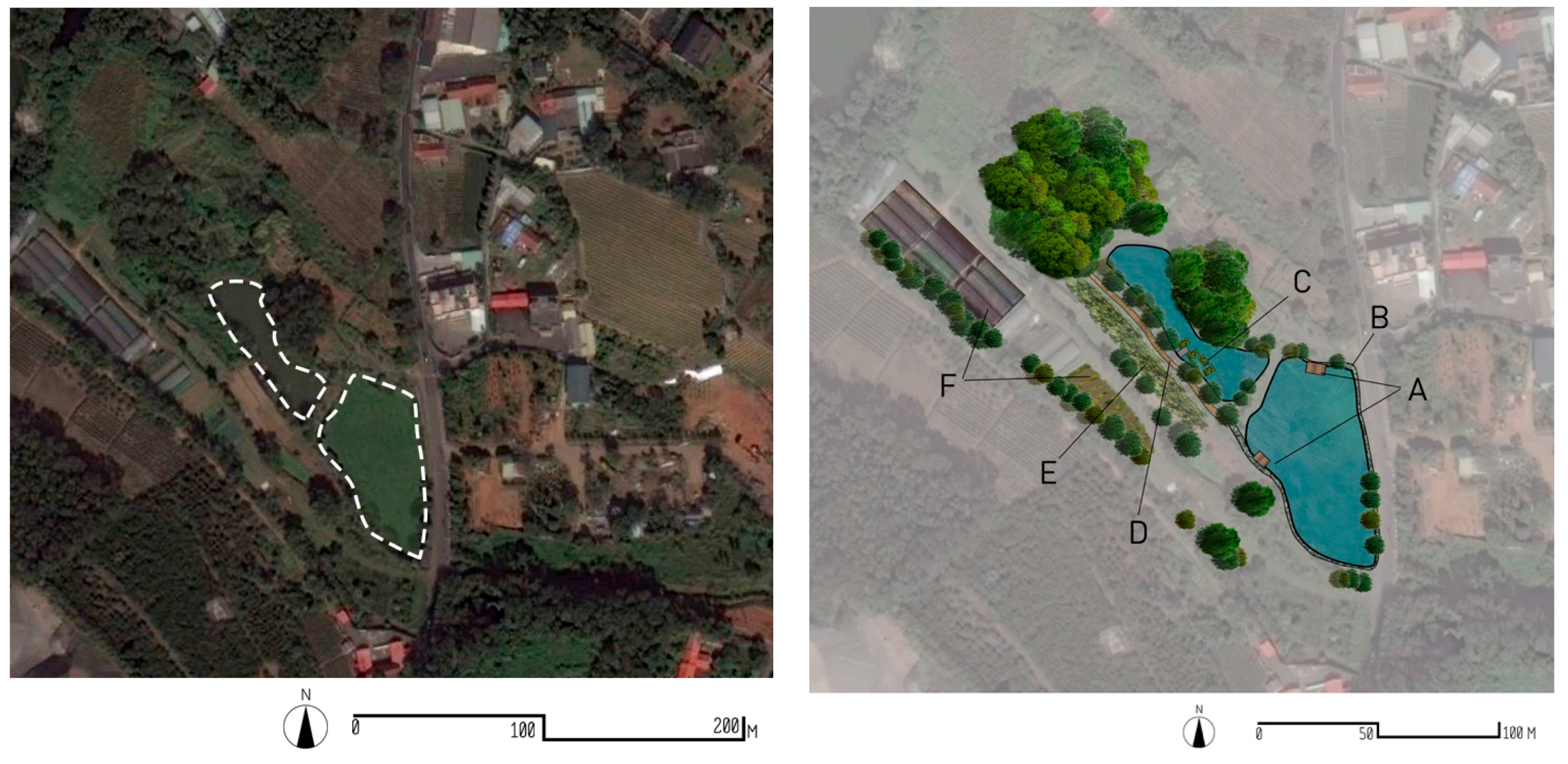

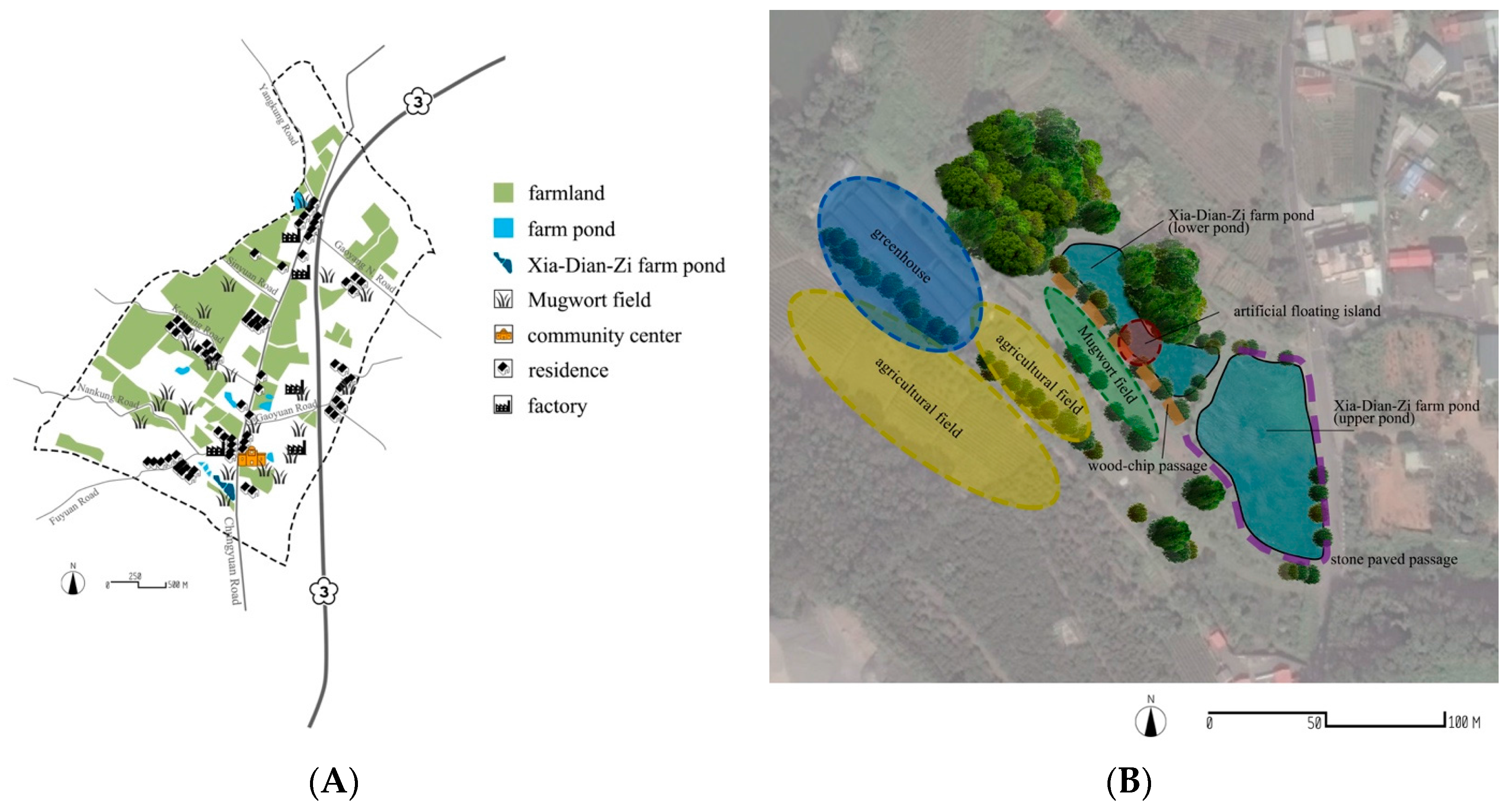
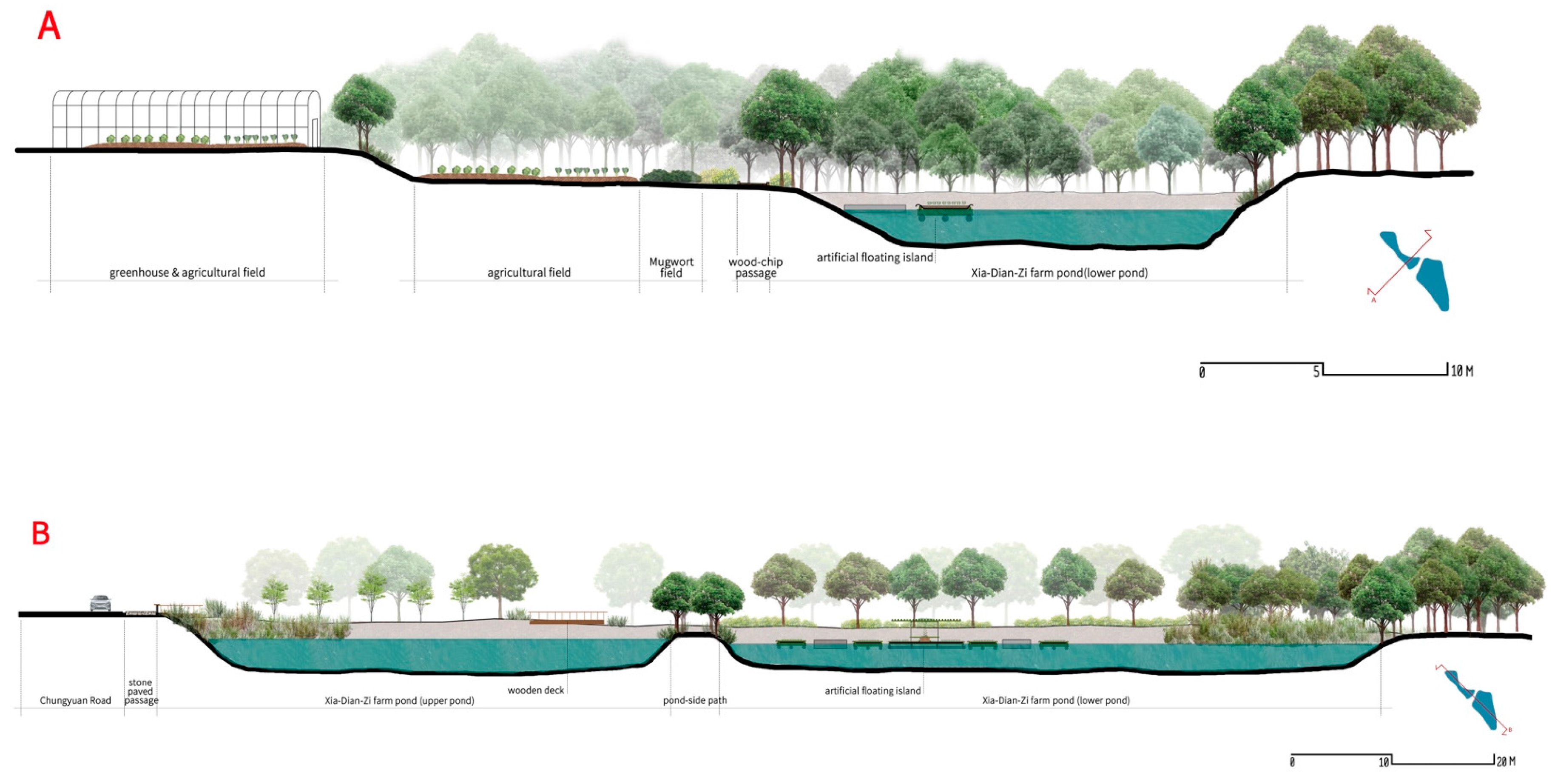
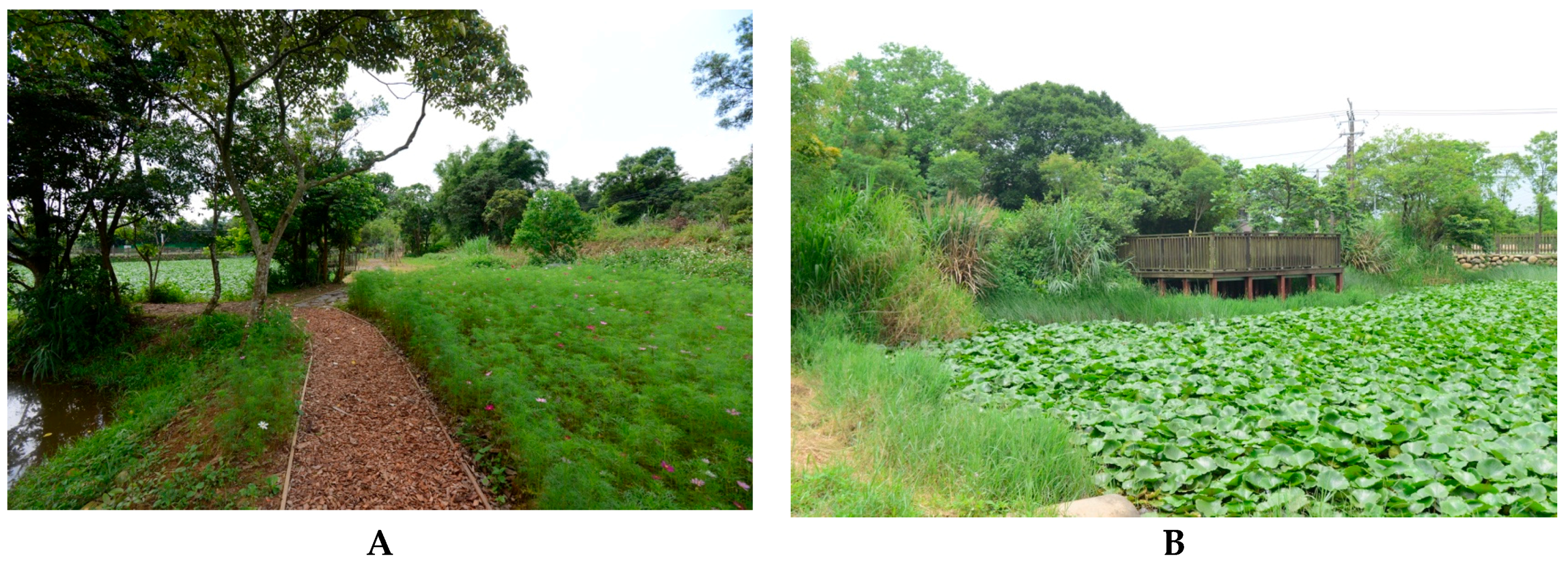
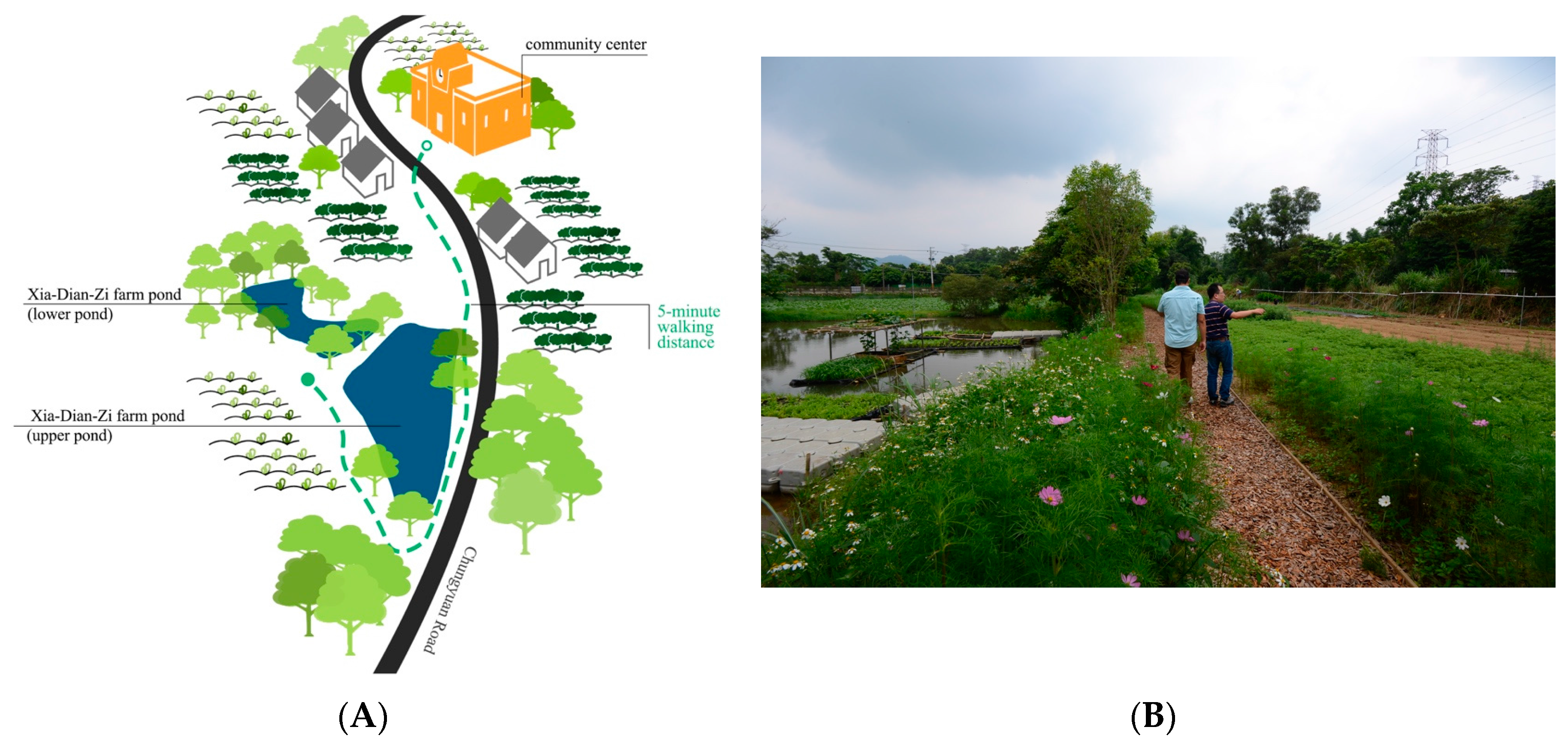
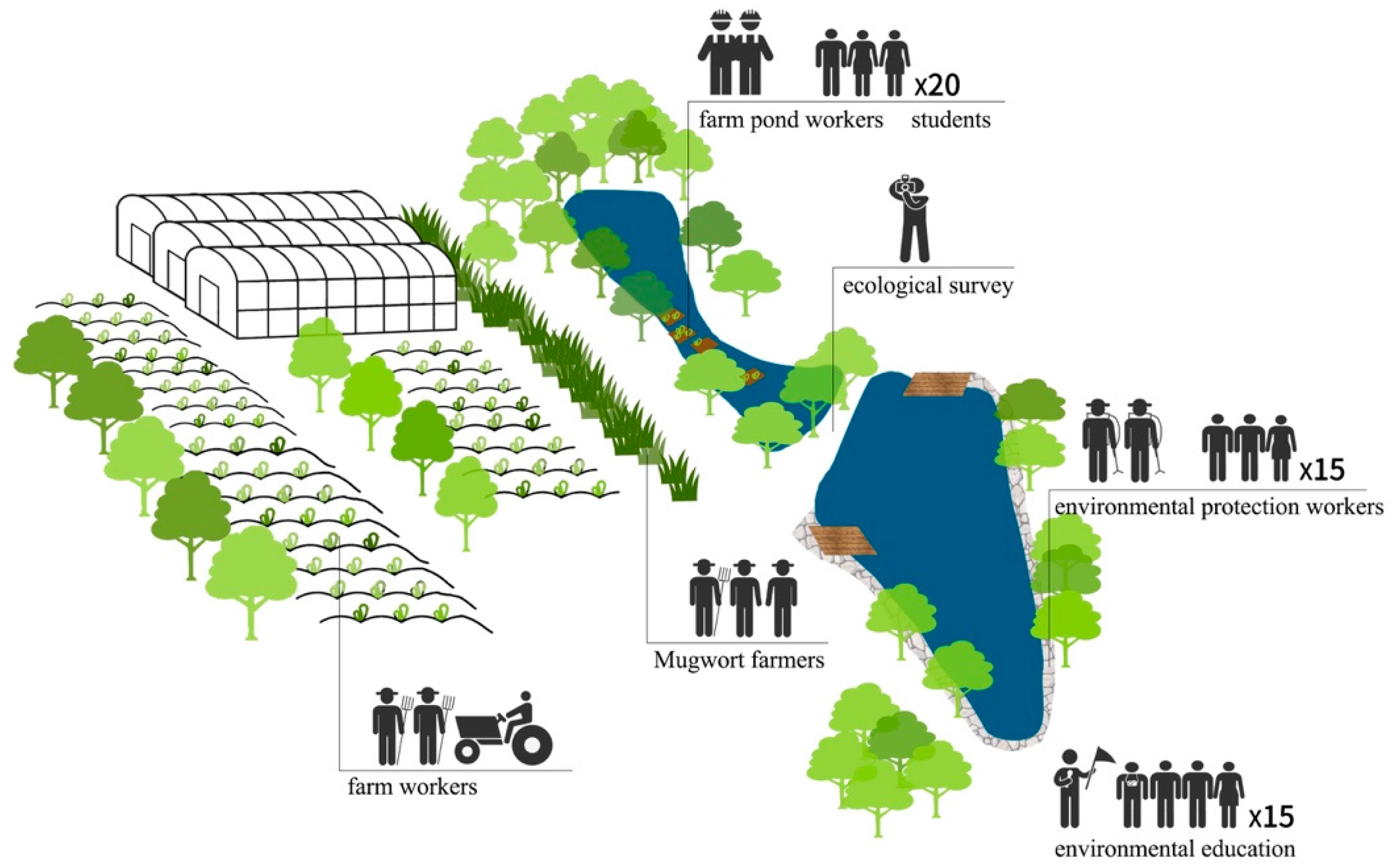
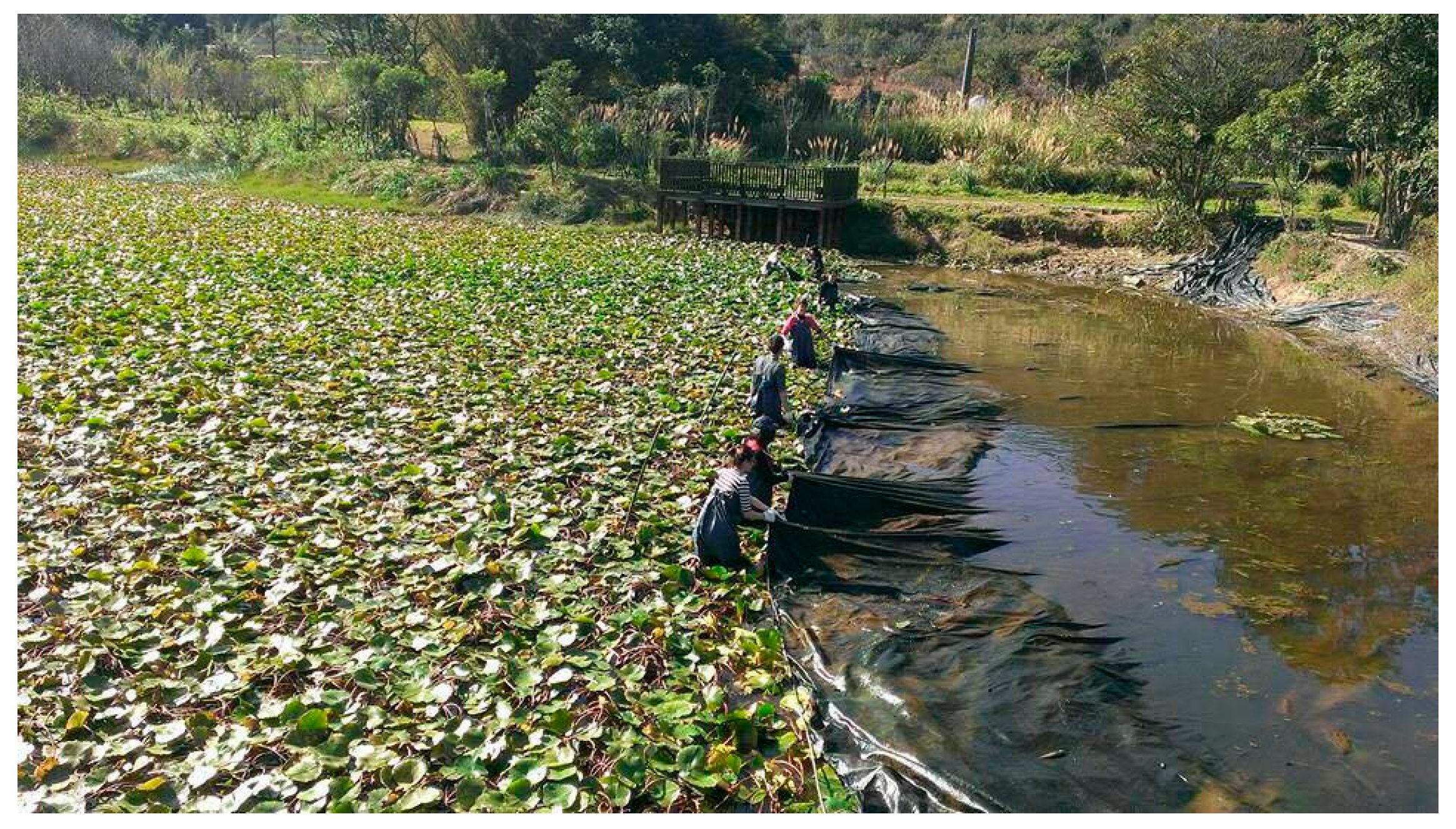
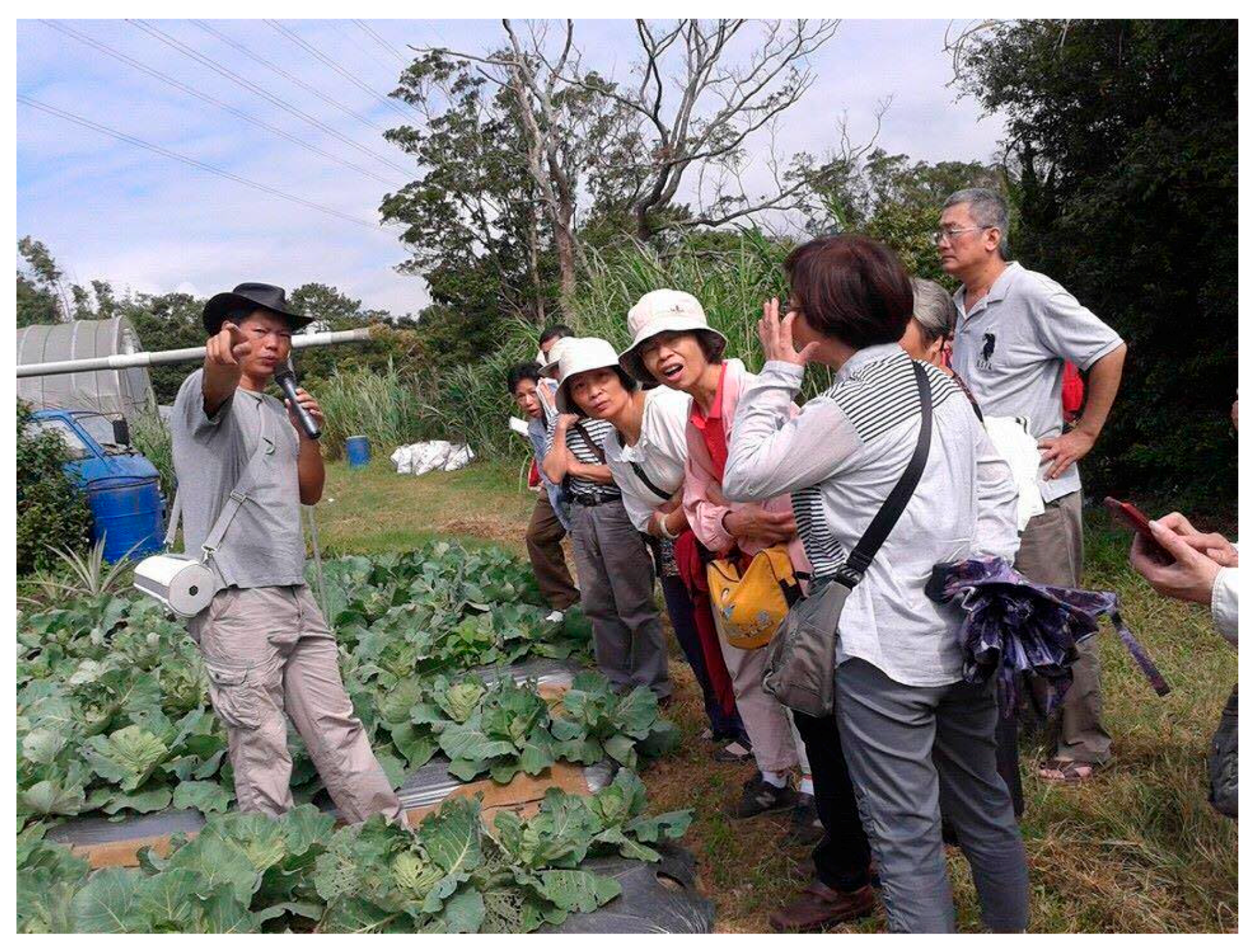
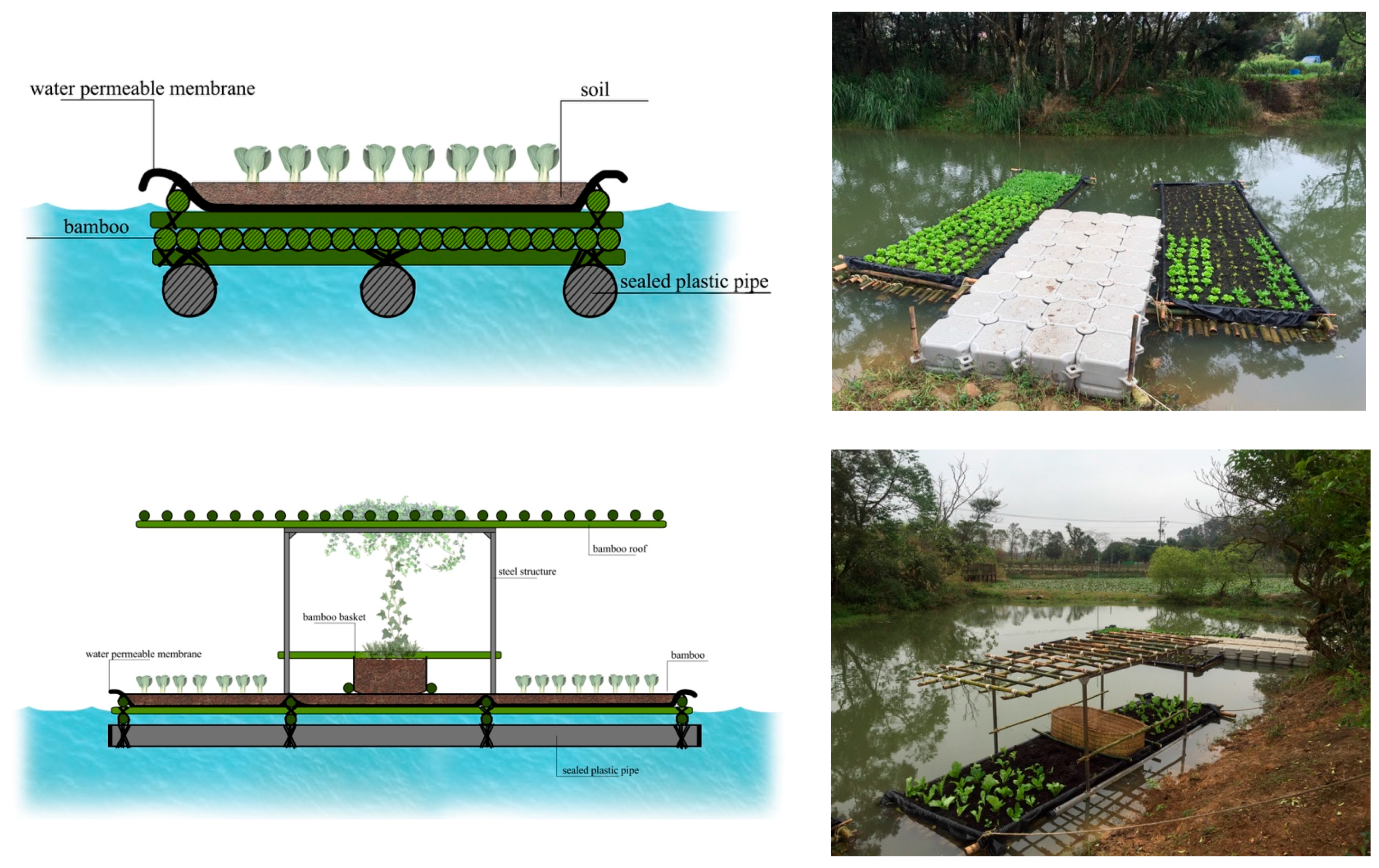
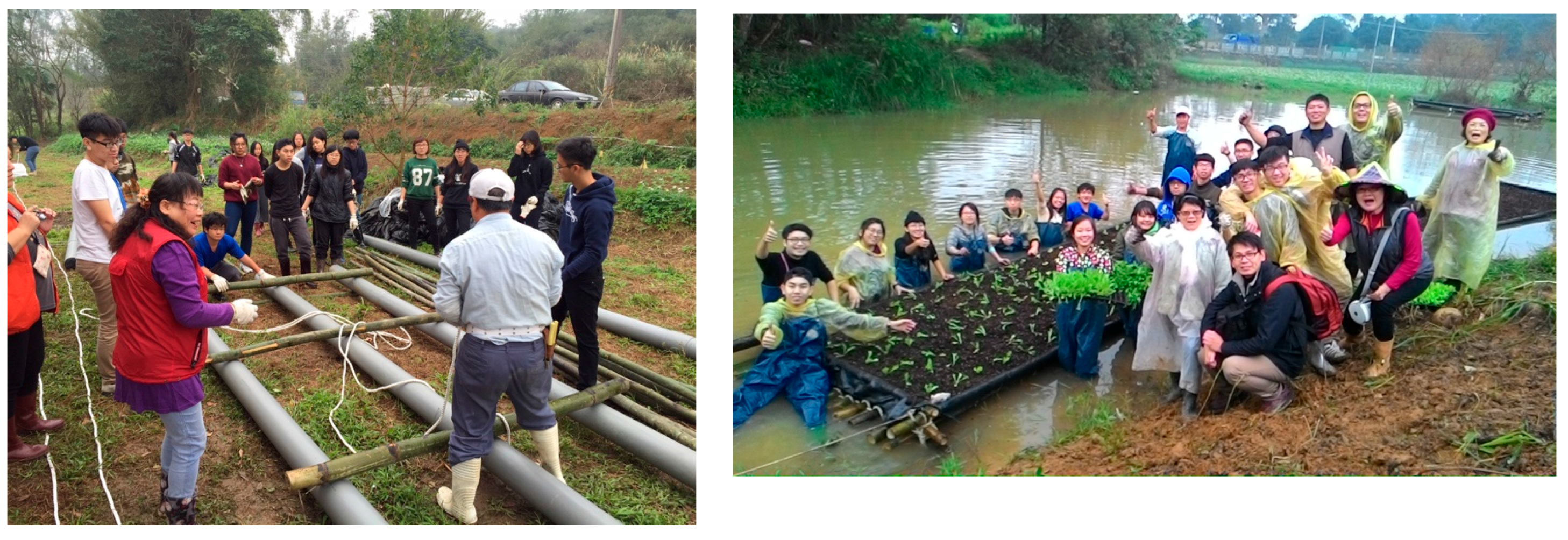
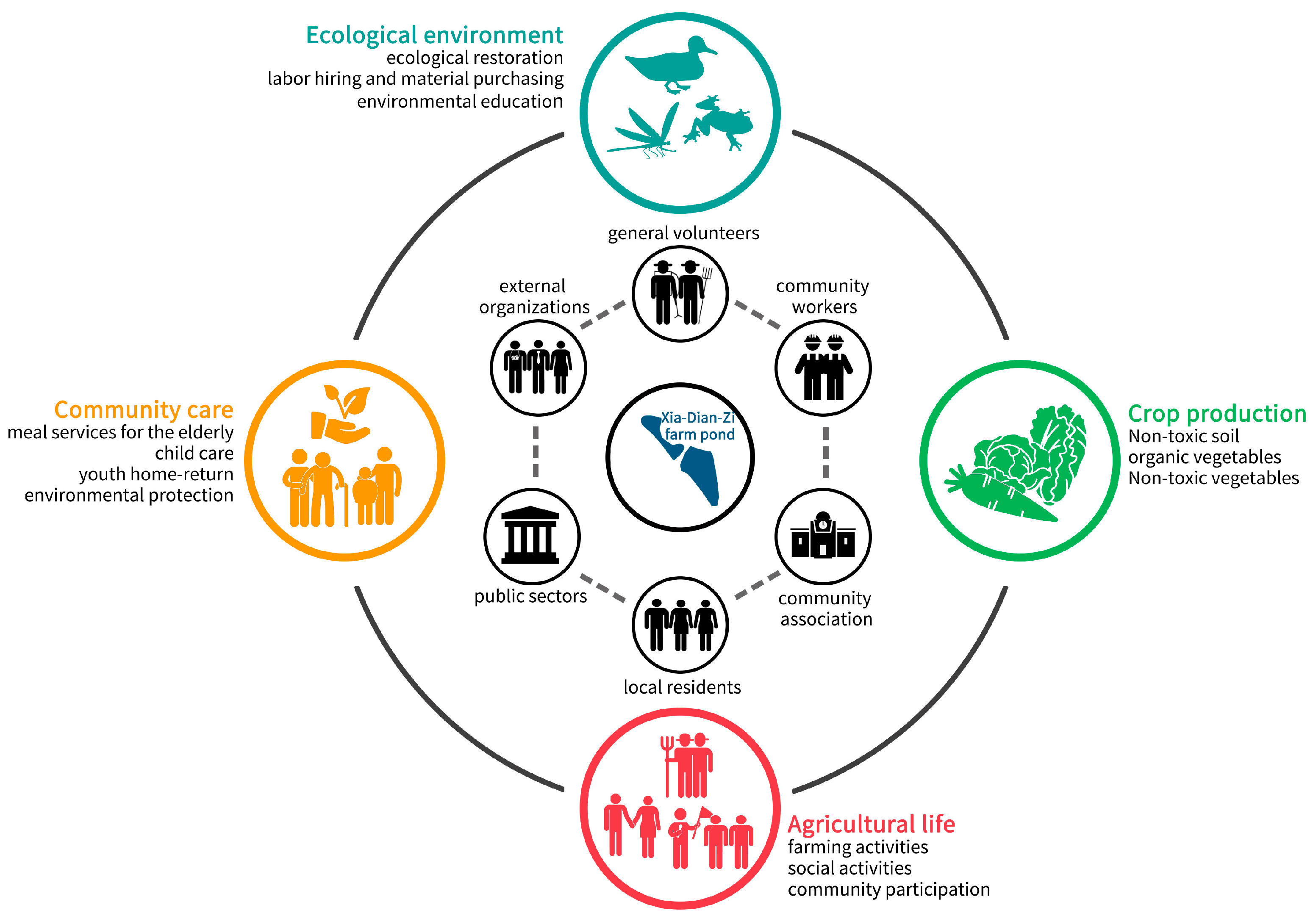
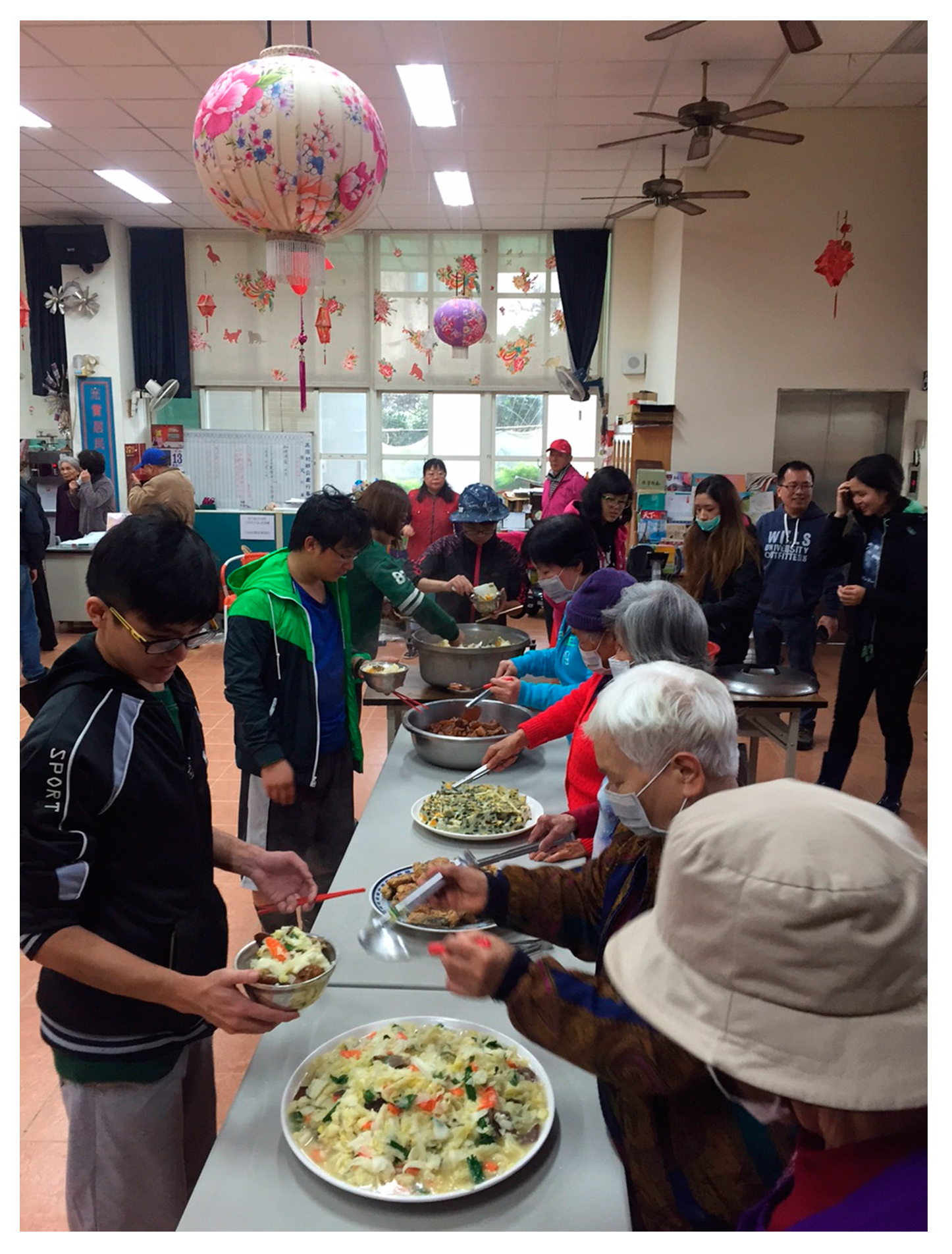
| ID Code | Age Group | Gender | Role | Participation | Occupation |
|---|---|---|---|---|---|
| IV1 | 50–59 | Female | The coordinator of community affairs | 20 years | The leader of the community |
| IV2 | 60–69 | Male | A team leader of farm pond workers and farmers | 5 years | Retired |
| IV3 | 70–79 | Male | A team leader of farm pond workers and farmers | 5 years | Retired |
| IV4 | 40–49 | Male | A farmer and leading teacher of environmental education sessions | 10 years | The greenhouse owner |
| IV5 | 50–59 | Female | A team leader of environmental protection workers | 8 years | Retired |
| IV6 | 50–59 | Female | A team leader of community workers and community kitchen workers | 10 years | Retired |
| IV7 | 50–59 | Male | A decision-maker for local policy | 15 years | Government official |
© 2017 by the authors. Licensee MDPI, Basel, Switzerland. This article is an open access article distributed under the terms and conditions of the Creative Commons Attribution (CC BY) license (http://creativecommons.org/licenses/by/4.0/).
Share and Cite
Chou, R.-J.; Wu, C.-T.; Huang, F.-T. Fostering Multi-Functional Urban Agriculture: Experiences from the Champions in a Revitalized Farm Pond Community in Taoyuan, Taiwan. Sustainability 2017, 9, 2097. https://doi.org/10.3390/su9112097
Chou R-J, Wu C-T, Huang F-T. Fostering Multi-Functional Urban Agriculture: Experiences from the Champions in a Revitalized Farm Pond Community in Taoyuan, Taiwan. Sustainability. 2017; 9(11):2097. https://doi.org/10.3390/su9112097
Chicago/Turabian StyleChou, Rung-Jiun, Chen-Ting Wu, and Feng-Tzu Huang. 2017. "Fostering Multi-Functional Urban Agriculture: Experiences from the Champions in a Revitalized Farm Pond Community in Taoyuan, Taiwan" Sustainability 9, no. 11: 2097. https://doi.org/10.3390/su9112097
APA StyleChou, R.-J., Wu, C.-T., & Huang, F.-T. (2017). Fostering Multi-Functional Urban Agriculture: Experiences from the Champions in a Revitalized Farm Pond Community in Taoyuan, Taiwan. Sustainability, 9(11), 2097. https://doi.org/10.3390/su9112097





